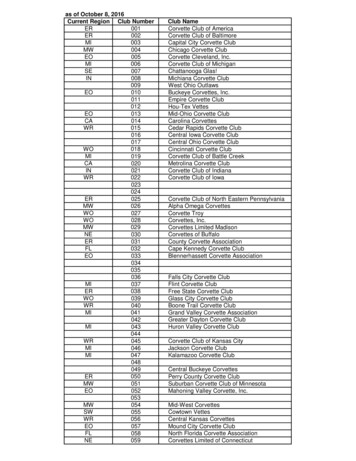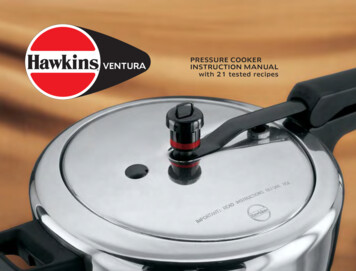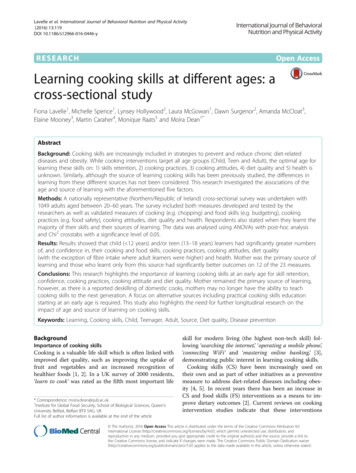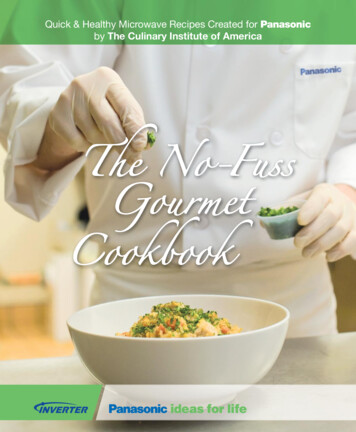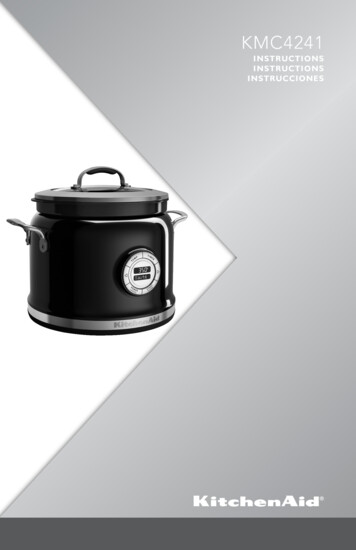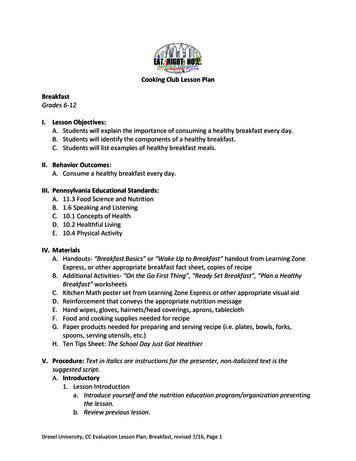
Transcription
Cooking Club Lesson PlanBreakfastGrades 6-12I. Lesson Objectives:A. Students will explain the importance of consuming a healthy breakfast every day.B. Students will identify the components of a healthy breakfast.C. Students will list examples of healthy breakfast meals.II. Behavior Outcomes:A. Consume a healthy breakfast every day.III. Pennsylvania Educational Standards:A. 11.3 Food Science and NutritionB. 1.6 Speaking and ListeningC. 10.1 Concepts of HealthD. 10.2 Healthful LivingE. 10.4 Physical ActivityIV. MaterialsA. Handouts- “Breakfast Basics” or “Wake Up to Breakfast” handout from Learning ZoneExpress, or other appropriate breakfast fact sheet, copies of recipeB. Additional Activities- “On the Go First Thing”, “Ready Set Breakfast”, “Plan a HealthyBreakfast” worksheetsC. Kitchen Math poster set from Learning Zone Express or other appropriate visual aidD. Reinforcement that conveys the appropriate nutrition messageE. Hand wipes, gloves, hairnets/head coverings, aprons, tableclothF. Food and cooking supplies needed for recipeG. Paper products needed for preparing and serving recipe (i.e. plates, bowls, forks,spoons, serving utensils, etc.)H. Ten Tips Sheet: The School Day Just Got HealthierV. Procedure: Text in italics are instructions for the presenter, non-italicized text is thesuggested script.A. Introductory1. Lesson Introductiona. Introduce yourself and the nutrition education program/organization presentingthe lesson.b. Review previous lesson.Drexel University, CC Evaluation Lesson Plan, Breakfast, revised 7/16, Page 1
c. Briefly introduce the lesson topic and recipe that will be prepared. Explain that inthis lesson, students will learn why it is important to eat a healthy breakfastevery day and what foods to include as part of a healthy breakfast.B. Developmental1. Discussion of lesson topica. Ask students to raise their hands if they ate breakfast this morning.b. Ask students how they feel if they skip breakfast in the morning. If you skipbreakfast, you might feel tired, hungry, irritable, and could have trouble focusingor concentrating. You might also get a stomachache, headache, or feel dizzy orlightheaded. Eating breakfast in the morning can be quick and easy and can helpyou to overcome these feelings.c. Ask students why they might skip breakfast in the morning. Discuss responses.Some reasons for skipping breakfast might include not having enough time, nothaving anything available to eat at home, not liking the options available.d. Ask students why they think it is important to eat a healthy breakfast every day.Discuss all reasonable answers. Be sure to explain that: Breakfast is the mostimportant meal of the day because it supplies our bodies with energy andnutrients and helps us to think and perform better in school and in otheractivities that we may do in a day. Eating breakfast can also help us to maintain ahealthy body weight.e. Discuss the components of a healthy breakfast. Use “Breakfast Basics” or “WakeUp to Breakfast” handout as a guide for discussion.i. A healthy breakfast should include a good balance of foods and nutrients.ii. Include a carbohydrate, protein, and healthy fat to give you energy and keepyou full until lunch. Complex carbohydrates (carbohydrates that have starchand/or fiber) will help you feel energized and ready to start the day, whileprotein and fat will keep you feeling full and minimize feelings of hunger.Choosing carbohydrate-rich foods that also provide fiber, like whole grains,can also help you to feel full longer.iii. For grades 9-12, discuss each nutrient in more detail.(a) Carbohydrates- Carbohydrates provide the primary fuel for our brains.There are two different types of carbohydrates: simple and complex.Simple carbohydrates (sugar) are found naturally in foods like fruit andmilk and are also contained in foods with added sugars. We want to limitthe added sugars in our diet to less than 10% of total calories daily. For anaverage 2000 calorie diet, the limit would be 50 grams per day. Complexcarbohydrates (starches) are found in foods like grains, beans, andcertain vegetables. Choosing complex carbohydrates that also containfiber, like whole grains, will help you to feel full so you won’t get hungryagain before lunch.(b) Protein- Include a protein that is low in saturated fat to help you feel fulland last until lunchtime without getting hungry. Some examples ofhealthy protein foods to include with breakfast are eggs/egg whites,Drexel University, CC Evaluation Lesson Plan, Breakfast, revised 7/16, Page 2
peanut butter or other nut butters, and low-fat or fat free dairy productslike milk, yogurt, and cheese.(c) Fat- Healthy fats provide energy and essential fatty acids for our bodies.We should try to choose monounsaturated and polyunsaturated fatsfrom plant-based foods and oils and limit our intake of saturated fats.Some examples of foods with healthy fats are nuts and nut butters,avocados, and plant-based oils.iv. Include at least three food groups to get a good balance of carbohydrates,protein, and healthy fat. A combination of grains, fruits (or vegetables), anddairy (or protein) can provide that balance.v. Ask students: What are some examples of healthy breakfast foods that couldbe combined to make a healthy meal. See below for examples.Whole GrainsWhole grain cerealWhole wheat toastWhole grain bagelWhole wheat EnglishmuffinOatmealWhole grain pancakesor wafflesWhole grain cereal baror granola barFruits/VegetablesPiece of fruit- apple,banana, orangeSliced/cut fruitstrawberries, avocado100% fruit juiceDried fruit- raisins,prunes, apricotsRaw or cooked veggiespeppers, onions, tomato,spinach (could put witheggs)Dairy/ProteinLow-fat or fat-free milkAlmond milk, soy milk, orother milk alternativeLow-fat or non-fat yogurtLow fat cheese- string,sliced, or shreddedEggs, egg whites or eggsubstitutePeanut, almond, orcashew buttervi. Remind the students: You don’t have to eat “breakfast” foods in the morning.As long as you include foods from at least three food groups to get a goodbalance of nutrients, you can eat a variety of foods for breakfast. Forexample, it’s ok to eat leftovers or dinner foods for breakfast, but try to optfor healthier options that have good sources of whole grains, fruits orvegetables, and lean protein/low-fat or fat-free dairy.2. Discussion of Measuring Techniquesa. Refer to “Kitchen Math” poster set from Learning Zone Express or other visualthat displays measuring techniques.b. Dry Measuring Cups- use for measuring dry ingredients, like flour, or solidingredients, like peanut butter. Choose the correct size cup, fill with theingredient and level with a straight edge (spatula or knife).c. Liquid Measuring Cups- use for liquid ingredients, like water, milk, or oil. Placemeasuring cup on a flat surface. Pour liquid ingredient into the cup and stop atDrexel University, CC Evaluation Lesson Plan, Breakfast, revised 7/16, Page 3
the line for desired amount. Read at eye level, not from above, while pouring.Liquid should just touch the measurement line.d. Measuring Spoons- use for small amounts of liquid or dry ingredients. For liquid,fill the correct spoon to the rim with the ingredient. For dry/solid, fill the correctspoon, then level off with a spatula or knife.3. Cooking Activitya. Distribute copies of recipe to students. Suggested recipes are provided but maybe altered as needed. When selecting a recipe, choose recipes that haveingredients from at least three food groups and can be prepared within theallotted time.b. Review the ingredients and instructions for preparing the recipe.c. Remind students of food safety guidelines and proper cooking equipment use.d. Involve students in food preparation and cooking. Choose volunteers and assigneach student a task or have groups of students take turns assisting.e. Discuss the following points while cooking:i. Have students identify in which food group each ingredient belongs.ii. Grades 9-12: Discuss the nutrients that are found in the ingredients.f. Provide each student with a sample sized portion of the recipe to taste.4. Additional activities: may be used with students who are not participating in cookingor as a follow-up activitya. On the Go First Thing worksheet (Grades 6-8 or 9-12)i. Have students work alone or in groups to complete the worksheet bymatching the vocabulary words to their definitions.ii. Review the correct answers.b. Ready Set Breakfast worksheet (Grades 6-8)i. Have students work alone or in groups to complete the worksheet by usingthe words from the top of the page to answer the clues.ii. Review the correct answers.c. Plan a Healthy Breakfast worksheet (Grades 9-12)i. Have students work alone or in groups to complete the worksheet by creatingthree different breakfast meals for the scenarios listed.ii. After students complete the activity, ask for volunteers to share their ideasfor healthy breakfast meals for each situation.C. Conclusion1. Review take-away messages from lesson.a. Ask students to explain why it is important to eat a healthy breakfast every day.Eating a healthy breakfast every day will provide your body with the energy andnutrients it needs in the morning, can help you perform better in school, andhelp you to maintain a healthy weight.b. Ask students what nutrients and food groups should be included in a healthybreakfast. A healthy breakfast should include food from at least three foodgroups to get a balance of carbohydrates, protein, and healthy fats along withvitamins and minerals.Drexel University, CC Evaluation Lesson Plan, Breakfast, revised 7/16, Page 4
2. Distribute the reinforcement, read the message and/or explain the reason why theyare receiving the reinforcement.3. Distribute Ten Tips Fact Sheet (or other appropriate fact sheet) and encouragestudents to share it with their families.4. Thank the students for their participation and answer any question they may have.Drexel University, CC Evaluation Lesson Plan, Breakfast, revised 7/16, Page 5
Breakfast Burrito with SalsaServing Size: 1 burritoYield: 4 servingsTime: 30 minutesIngredients: 2 Tablespoons canned corn 2 Tablespoons diced green peppers 1/4 cup minced onions 1 Tablespoon diced canned tomatoes, drained 1/4 teaspoon granulated garlic (optional) Nonstick spray 1 cup pasteurized liquid eggs 1 Tablespoon 1% milk 1 teaspoon mustard 1/4 teaspoon hot pepper sauce (optional) 4 - 8 inch flour (preferably whole grain) tortillas 1/4 cup canned salsa Salt and Pepper to tasteInstructions:1. Spray skillet and adjust to 350 degrees. Place corn,green pepper, onions, tomatoes and garlic on sprayedskillet and cook until tender.2. In a large mixing bowl, blend the eggs, milk, mustardand hot pepper sauce for 1 minute until smooth.3. Pour egg mixture over vegetables into the sprayed skillet.4. Scramble egg mixture until it is thoroughly cooked. Remove from skillet and put in servingdish.5. Place tortillas on the skillet to warm them.6. Place a scoop of cooked egg in each tortilla and roll it up.7. Serve each burrito topped with 2 Tablespoons of ed from:Food Family FunUSDA Food and Nutrition Services (FNS)Drexel University, CC Evaluation Lesson Plan, Breakfast, revised 7/16, Page 6
Banana Pancakes with Strawberry ToppingServing Size: 2 pancakes (1/6 of recipe)Yield: 6 servingsIngredients:½ cup liquid pasteurized eggs1 ½ cups 1% milk1 Tablespoon honey**3 Tablespoons oil¾ cup whole wheat flour¾ cup all purpose flour2 teaspoons baking powder2 bananasNon stick sprayStrawberry Topping:1 pint strawberries (about 2 ½ cups sliced)3 Tablespoons sugar¼ cup waterInstructions:Strawberry Topping:1. Wash strawberries, remove caps, and slice.2. Combine strawberries with the sugar, and water.3. While preparing pancake batter, cook strawberry topping in separate skillet over medium heat for 5-10 minutes.4. Put to the side as a topping for completed pancakes.Pancakes:1. Add eggs to mixing bowl. Beat in milk, honey and oil.2. Add flours and baking powder.3. Slice bananas and add to mixture.4. Coat a large, non-stick frying pan or griddle with non-stick cooking spray. Warm the pan over medium heat for 2minutes.5. Spoon ¼ cup of the batter onto the heated griddle for each pancake (adjust more or less depending on pancakesize).6. Cook until the tops are bubbly and the pancakes are dry around the edges. Flip and cook for 2-3 minutes or untilgolden on both sides. Place pancakes on a platter and keep warm.7. Repeat steps 5 and 6 until batter has been used, using more non-stick cooking spray as needed.**Note: Infants 12 months and under should NOT be given honey.Cost: Per Recipe: 2.45 Per Serving: 0.41Source: Adapted from: Pumpkin Post/Banana BeatUniversity of Massachusetts Extension Nutrition Education Program http://recipefinder.nal.usda.govDrexel University, CC Evaluation Lesson Plan, Breakfast, revised 7/16, Page 7
Gingerbread French ToastServing Size: 1 sliceYield: 16 slicesTime: 30 minutesIngredients:2 cups liquid pasteurized eggs2 cups fat free milk4 teaspoons cinnamon4 teaspoons ground ginger1 teaspoon allspice1 teaspoon pure vanilla extract16 slices whole wheat bread16 Tablespoons zero calorie syrupNonstick cooking sprayInstructions:1.2.3.4.5.6.Pour the eggs, milk, cinnamon, ginger, vanilla, and allspice into the same bowl.Whisk the mixture until it is one color.Turn skillet on medium high heat and spray with cooking spray.Use a fork to dip bread slices into mixture and then place on skillet.Cook until the underneath is brown, and then flip.Serve with 1 tablespoon zero calorie syrup.Source:“Honest Pretzels” Cookbook by Mollie KatzenDrexel University, CC Evaluation Lesson Plan, Breakfast, revised 7/16, Page 8
On the Go First ThingName: Date:Directions: Match the words on the left with the correct definition on the right.Vocabulary WordsCALORIESA.This nutrient helps to build muscle and provides afeeling of fullness. Eggs, nuts, nut butters, and lowfat milk are good sources of this nutrient.B.Examples of these include carbohydrates, protein,fat, vitamins, and minerals. Some provide energyfor your body, and they all are needed to keepyour body healthy.C.This nutrient is found in milk and dairy products. Ithelps to keep your bones and teeth and strong.Include a food with this as part of a healthybreakfast.D.This nutrient is found in foods like whole grains,fruits, and vegetables. If you include it with yourbreakfast, it can help keep you full until lunch.E.This nutrient provides energy and can help keepyou feeling full. Avocados, nuts, nut butters, andplant oils all contain the healthy type of thisnutrient.F.This nutrient provides fuel for our brains andmuscles. Cereal, oatmeal, toast, pancakes, waffles,and bagels all contain this nutrient.G.This is a unit used to measure the amount ofenergy in a food. You need energy in the morningto fuel your body and brain so you can concentrateand do your best.H.These foods contain carbohydrates to give yourbody and brain energy in the morning. They alsocontain another nutrient that can help keep youfull.PROTEINCARBOHYDRATEFATNUTRIENTSWHOLE GRAINSCALCIUMFIBERDefinitions
On the Go First ThingANSWER KEYName: Date:Directions: Match the words on the left with the correct definition on the right.Vocabulary WordsGAFEBHCDCALORIESA.This nutrient helps to build muscle and provides afeeling of fullness. Eggs, nuts, nut butters, and lowfat milk are good sources of this nutrient.B.Examples of these include carbohydrates, protein,fat, vitamins, and minerals. Some provide energyfor your body, and they all are needed to keepyour body healthy.C.This nutrient is found in milk and dairy products. Ithelps to keep your bones and teeth and strong.Include a food with this as part of a healthybreakfast.D.This nutrient is found in foods like whole grains,fruits, and vegetables. If you include it with yourbreakfast, it can help keep you full until lunch.E.This nutrient provides energy and can help keepyou feeling full. Avocados, nuts, nut butters, andplant oils all contain the healthy type of thisnutrient.F.This nutrient provides fuel for our brains andmuscles. Cereal, oatmeal, toast, pancakes, waffles,and bagels all contain this nutrient.G.This is a unit used to measure the amount ofenergy in a food. You need energy in the morningto fuel your body and brain so you can concentrateand do your best.H.These foods contain carbohydrates to give yourbody and brain energy in the morning. They alsocontain another nutrient that can help keep youfull.PROTEINCARBOHYDRATEFATNUTRIENTSWHOLE GRAINSCALCIUMFIBERDefinitions
Ready, Set, Breakfast!Use the words below to complete the dian BaconPeanut Butter1. This white or chocolate drink is perfect with any breakfast2. Raisins are dried3. I am eaten in a bowl with milk and a spoon4. I am a creamy treat that can be fruity too5. I am the top and bottom of a breakfast sandwich6. This fruit has the same color as its name7. I am a monkey’s favorite food8. I can be scrambled, fried, or hard boiled9. I am spread on bread with jelly10. Melt this on a bagel or toast11. I am red and sweet12. This cereal warms you up in the morning13. I am yummy with maple syrup14. I am the breakfast meat with the least amount of fat15. Reheat and eat me from the night before
Ready, Set, Breakfast!ANSWER heeseMilkGrapesToastBananaStrawberriesCanadian BaconPeanut Butter1. This white or chocolate drink is perfect with any breakfast MILK2. Raisins are dried GRAPES3. I am eaten in a bowl with milk and a spoon CEREAL4. I am a creamy treat that can be fruity too YOGURT5. I am the top and bottom of a breakfast sandwich TOAST6. This fruit has the same color as its name ORANGE7. I am a monkey’s favorite food BANANA8. I can be scrambled, fried, or hard boiled EGGS9. I am spread on bread with jelly PEANUT BUTTER10. Melt this on a bagel or toast CHEESE11. I am red and sweet STRAWBERRIES12. This cereal warms you up in the morning OATMEAL13. I am yummy with maple syrup PANCAKES14. I am the breakfast meat with the least amount of fat CANADIAN BACON15. Reheat and eat me from the night before LEFTOVERS
Plan a Healthy BreakfastFor each situation listed, plan a healthy breakfast. Then, check the food groups andnutrients that each meal would provide.Breakfast at HomeFood Groups Grains Fruits Vegetables Dairy ProteinNutrients Carbohydrate Protein Healthy FatBreakfast on the GoFood Groups Grains Fruits Vegetables Dairy ProteinNutrients Carbohydrate Protein Healthy FatBreakfast Away from HomeFood Groups Grains Fruits Vegetables Dairy ProteinNutrients Carbohydrate Protein Healthy FatDo all of your breakfast meals include at least three food groups? YES NODo all of your meals include carbohydrates, protein, and healthy fats? YES NOIf you answered NO to either question, go back and revise meals to include at leastthree food groups and all three nutrients.
Low-fat or fat-free milk Almond milk, soy milk, or other milk alternative : Low-fat or non-fat yogurt . . Read at eye level, not from above, while pouring. Liquid should just touch the measurement line. . 1 ½ cups 1% milk 1 Tablespoon honey** 3 Tablespoons oil ¾ cup whole wheat flour ¾ cup all purpose flour

